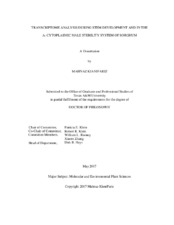| dc.description.abstract | Sorghum (Sorghum bicolor (L) Moench) exhibits efficient use of water, nitrogen and energy resources and is grown throughout the world as a cereal, forage, syrup and more recently energy crop. A high-throughput RNA sequencing method (RNA-seq) was used to examine transcriptional dynamics during stem development of two genotypes of sorghum, i.e., BTx623 and R07020. A comparative transcriptome analysis of immature panicles was also conducted between a set of cytoplasmic male sterile (CMS) A1-lines, iso-cytoplasmic maintainer B-lines, and F1 sorghum hybrids.
By comparing stem nodal segments each at unique stages of cell wall deposition, more than 500 differentially expressed genes (DEGs) were identified that were annotated as being involved in processes related to cell wall biosynthesis. Categories of DEGs included genes involved in cellulose, hemicellulose, and lignin biosynthesis, transcription factors, glycosyl transferases and cell wall proteins. In non-elongating mature nodal segments actively laying down secondary cell walls, transcriptome profiles revealed inter-related biosynthetic pathways that were highly enriched in DEGs involved in phenylpropanoid metabolism and flavonoid biosynthesis. In immature nodal segments in the rapidly elongating region of the stem, a series of pathways enriched in DEGs were detected that are critical for the primary growth of stems including starch and sucrose metabolism and DNA replication. A co-expression network analysis identified a number of transcription factors with connectivity to lignin biosynthesis genes, which indicates a possible role for these transcription factors as regulators of lignin biosynthesis in sorghum. A number of DEGs were found by comparing nuclear gene expression of CMS A1-lines with associated B-lines and F1 hybrids. In general, a larger proportion of DEGs were down-regulated in CMS A1-lines when compared to pollen-fertile B-lines and F1 hybrids. GO categories whose genes were down-regulated in CMS A1-lines included metabolic processes, lipid biosynthetic/metabolic process, and oxidation/reduction. Examination of these DEGs (and their homologs) within these categories provided evidence that the down-regulation of these genes may relate to the production of viable pollen in fertile panicles. In pollen-sterile panicles of CMS A1-lines, up-regulated genes included several stress-related genes such as heat shock and linoleic acid biosynthesis genes. | en |


